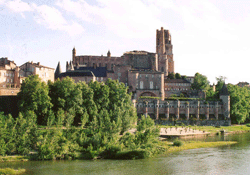


 Albi
is an attractive Market town with a Spectacular Cathedral.
Along with Toulouse
and Montauban, Albi is one of the main cities built in Languedoc
brick - essentially the style of ancient Roman bricks.
Albi
is an attractive Market town with a Spectacular Cathedral.
Along with Toulouse
and Montauban, Albi is one of the main cities built in Languedoc
brick - essentially the style of ancient Roman bricks.
Albi is the capital (préfecture) of the Tarn département,
and is located on the Tarn River, 50 miles northeast of
Toulouse. Its inhabitants are called Albigeois (m) or Albigeoises(f).
History
The first known human settlement in Albi dates from the
Bronze Age, but little remains from this period. After the
Roman
conquest of Gaul in 51 BC, the town became "Civitas
Albigensium", the territory of the Albigeois, "Albiga".
Archaeological digs have not revealed any traces of Roman
buildings, suggesting that Albiga must have been a modest
Romans
settlement.
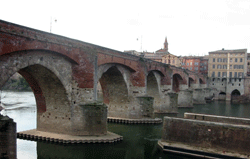
 In
1035 - 1040, a bridge now known as the Pont Vieux (Old Bridge)
was built. The city grew rich at this time, a result of
the trade that the bridge brought, and also to the tolls
charged for crossing it. The Pont Vieux is still in use
today. Originally built in stone), then clad with brick,
it rests on 8 arches and is 151m long. In the 14th century,
it was fortified and provided with a drawbridge. Houses
were built over the piers.
In
1035 - 1040, a bridge now known as the Pont Vieux (Old Bridge)
was built. The city grew rich at this time, a result of
the trade that the bridge brought, and also to the tolls
charged for crossing it. The Pont Vieux is still in use
today. Originally built in stone), then clad with brick,
it rests on 8 arches and is 151m long. In the 14th century,
it was fortified and provided with a drawbridge. Houses
were built over the piers.
Albi gave its name to a religious group more commonly known
as the Cathars.
The Roman Catholic authorities seem to have believed, mistakenly,
that Albi was the religion's centre in the Languedoc and
so called Cathar believers Albigoise or Albigensians. When
Pope Innocent II launched a war on the people of the Languedoc
and their rulers, including the Viscounts of Albi, it came
to be known as the Albigensian
Crusade.
|
After the upheaval of the Crusade against the Cathars,
the bishop Bernard de Castanet, in the late 13th century,
completed work on the Palais de la Berbie, the Bishops'
Palace. It has the look of a fortress. Bernard also
commissioned the building of the cathedral of Sainte-Cécile
starting in 1282. Its deliberate external austerity
represents an attempt by the Catholic authorities
to avoid ostentation, as it was known that people
favoured the Cathar religion over the Catholic religion
partially because of the Cathars' austerity and asceticism
From 1450 to 1560, Albi enjoyed a period of prosperity
largely due to the cultivation of Isatis Tinctoria
a dark blue dye known in French as pastel, in English
as woad and in Occitan as Cocanha. This was the original
Land of cocanha, or Land
of Cocaigne. Renaissance town houses in Albi of
the bear witness to the fortunes amassed by the cocanha
merchants. An historic area built around the cathedral
and episcopal buildings covers 63 hectares. Red brick
and tiles are the main feature of most of the buildings.
|
|

Pont Vieux (Old Bridge), Languedoc, France Photographic
Print
Wheeler, Nik |
|
Albi was the birthplace of Henri de Toulouse-Lautrec
(1864–1901). Today it is the home of the Toulouse-Lautrec
Museum. More than 1000 works, including the 31 famous posters,
are kept here. This body of work forms the largest public
collection in the world devoted to Toulouse-Lautrec.
The Cathedral
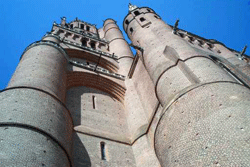
 Among
the monuments of the town is the Sainte Cécile cathedral,
claimed to be the world's largest brick construction. This
monument is in the Southern Gothic style. La Cathédrale
Sainte-Cécile d'Albi was constructed from 1282 to
1480. There is a strong contrast between its austere, defensive
exterior and its sumptuous interior decoration. Built as
an assertion of Catholic power after the upheavals of the
wars against the people of the Languedoc (The "Albigensian
Crusade"). Notable features are:
Among
the monuments of the town is the Sainte Cécile cathedral,
claimed to be the world's largest brick construction. This
monument is in the Southern Gothic style. La Cathédrale
Sainte-Cécile d'Albi was constructed from 1282 to
1480. There is a strong contrast between its austere, defensive
exterior and its sumptuous interior decoration. Built as
an assertion of Catholic power after the upheavals of the
wars against the people of the Languedoc (The "Albigensian
Crusade"). Notable features are:
The elaborate interior stands in stark contrast to the
cathedral's military exterior.
The Palais de la Berbie, formerly the Bishops' Palace of
Albi, is now the Toulouse-Lautrec Museum. Its name comes
from the Occitan
word Bisbia, meaning Bishops' Palace. It is one
of the oldest and best-preserved castles in France. It was
completed at the end of the 13th century.
| Albi is known in France for its elite
Lycée Lapérouse, a high school with 500
students situated inside an old monastery.
Geography
Albi is the chief town of 6 cantons, covering 18
communes, with a total population of 67,728. It lies
in the Midi-Pyrénées Region
Coordinates: Longitude: 43°55'44 N, Latitude 02°08'47
E
Altitude 130 m–308 m
INSEEcode 81004
Postal code 81000
|
|
|
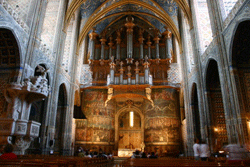
 Things
to See
Things
to See
Henri de Toulouse-Lautrec (1864-1901)
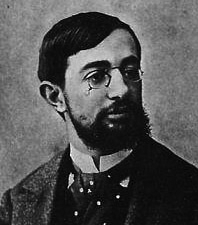
 Henri
de Toulouse-Lautrec was a native of Albi. His full name
was Henri Marie Raymond de Toulouse-Lautrec Monfa. He was
born on 24th November, 1864, the first child of Comte Alphonse
and Comtesse Adèle de Toulouse-Lautrec. The Count
and Countess were first cousins, and Henri suffered from
congenital health conditions attributed to this and other
family inbreeding. A younger brother was born on August
28, 1867, but died the following year.
Henri
de Toulouse-Lautrec was a native of Albi. His full name
was Henri Marie Raymond de Toulouse-Lautrec Monfa. He was
born on 24th November, 1864, the first child of Comte Alphonse
and Comtesse Adèle de Toulouse-Lautrec. The Count
and Countess were first cousins, and Henri suffered from
congenital health conditions attributed to this and other
family inbreeding. A younger brother was born on August
28, 1867, but died the following year.
At the age of 13 Henri fractured his left thigh bone, and
a year later his right one. The breaks did not heal properly
and his legs stopped growing. As an adult he stood 1.52
m or 5 ft tall, having developed an adult-sized torso but
retaining child-sized legs. Unable to participate in most
of the activities enjoyed by his peers, Toulouse-Lautrec
immersed himself in art.
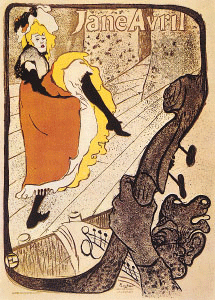
 His
mother took him to Paris where he entered professional teaching
studios in 1882. He settled in Montmartre in 1884. His immersion
in the decadent and theatrical life of fin de siècle
Paris yielded an oeuvre of provocative images of modern
life. His wit attracted a artists and intellectuals, including
Oscar Wilde and Vincent van Gogh. He studied with French
academic painters L. J. F. Bonnat and Fernand Cormon. He
became an important post-Impressionist painter, art nouveau
illustrator, and lithographer and recorded in his works
many details of the late-19th century bohemian lifestyle
in Paris.
His
mother took him to Paris where he entered professional teaching
studios in 1882. He settled in Montmartre in 1884. His immersion
in the decadent and theatrical life of fin de siècle
Paris yielded an oeuvre of provocative images of modern
life. His wit attracted a artists and intellectuals, including
Oscar Wilde and Vincent van Gogh. He studied with French
academic painters L. J. F. Bonnat and Fernand Cormon. He
became an important post-Impressionist painter, art nouveau
illustrator, and lithographer and recorded in his works
many details of the late-19th century bohemian lifestyle
in Paris.
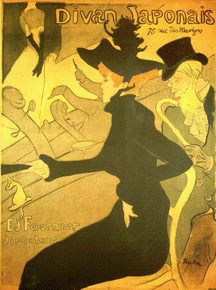
 Lautrec
met Edgar Degas who provided encouragement and some of Lautrec’s
lithographs reveal his debt to the older artist. His oeuvre
includes paintings, drawings, etchings, lithographs, and
posters, as well as illustrations for various contemporary
newspapers. He incorporated into his own individual method
elements of the styles of other contemporary artists, especially
Degas and Paul Gauguin. Japanese art influenced his use
of oblique angles, sharp delineation and flat areas of colour.
His work inspired van Gogh, Georges Seurat, and Georges
Rouault.
Lautrec
met Edgar Degas who provided encouragement and some of Lautrec’s
lithographs reveal his debt to the older artist. His oeuvre
includes paintings, drawings, etchings, lithographs, and
posters, as well as illustrations for various contemporary
newspapers. He incorporated into his own individual method
elements of the styles of other contemporary artists, especially
Degas and Paul Gauguin. Japanese art influenced his use
of oblique angles, sharp delineation and flat areas of colour.
His work inspired van Gogh, Georges Seurat, and Georges
Rouault.
Outstanding examples of his work are La Goulou Entering
the Moulin Rouge (1892, Musée Toulouse-Lautrec, Albi),
Jane Avril Entering the Moulin Rouge (1892, Courtauld Gallery,
London), and Au salon de la rue des Moulins (1894, Musée
Toulouse-Lautrec).
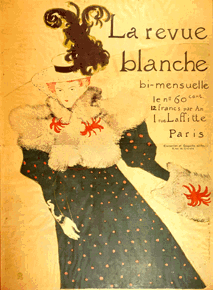
 He
was acclaimed as "The soul of Montmartre", the
Parisian quarter where he made his home, frequenting the
circus, the theater, and local brothels. He portrayed life
at the Moulin Rouge and other Montmartre and Parisian nightspots.
He lived in a brothel for long periods. He painted singer
Yvette Guilbert, Louise Weber (La Goulue) a dancer who created
the "French Can-Can", and the dancer Jane Avril.
Toulouse-Lautrec gave painting lessons to Suzanne Valadon,
one of his models. By the 1890s he had become a leading
figure in the Parisian art world. The largest exhibition
of his work during his lifetime was held at London’s
Goupil Gallery in 1898.
He
was acclaimed as "The soul of Montmartre", the
Parisian quarter where he made his home, frequenting the
circus, the theater, and local brothels. He portrayed life
at the Moulin Rouge and other Montmartre and Parisian nightspots.
He lived in a brothel for long periods. He painted singer
Yvette Guilbert, Louise Weber (La Goulue) a dancer who created
the "French Can-Can", and the dancer Jane Avril.
Toulouse-Lautrec gave painting lessons to Suzanne Valadon,
one of his models. By the 1890s he had become a leading
figure in the Parisian art world. The largest exhibition
of his work during his lifetime was held at London’s
Goupil Gallery in 1898.
An alcoholic for most of his adult life, in the 1890s he
began to drink even more heavily and was placed in a sanatorium.
He died from complications due to alcoholism and syphilis
on 9th September 1901 aged 36, at the family estate in Malromé.
He is buried in Verdelais, in the Gironde, a few kilometres
from his birthplace. He predeceased his father and so never
inherited the family title.
After his death, his mother, the Comtesse Adèle
Toulouse-Lautrec, and Maurice Joyant, his art dealer, promoted
his art. His mother contributed funds for a museum to be
built in Albi to house his works. Today he one of the most
famous artist in the world, his paintings selling for tens
and hundreds of millions.
The invention of a cocktail known as the Tremblement de
Terre (Earthquake) is attributed to Toulouse-Lautrec. It
contains four parts Absinthe, two parts Red Wine, and a
dash of Cognac.
The Archdiocese of Albi
Albi is an Roman Catholic Archdiocese, corresponding to
the Department of the Tarn. It became an archiepiscopal
see in 1678, was dissolved during the French Revolution
and re-established until 1822, when it was united Bishopric
of Castres.
A local tradition attributes the foundation of the see to
an African St. Clarus, who was later martyred. Like almost
all stories of this type it is entirely fictitious and dates
from the twelfth century. A more reliable story is that
in the fifth century, Eugene, a bishop from Carthage, founded
the first monastery of the Gauls here.
From the sixth to the eighth centuries, two families of
Albi produced a series of saints, the Salvia family (St.
Desiderius, St. Disciola) and the Ansbertina family (St.
Goéric, St. Sigisbald, and St. Sigolina).
The parish church of Lautrec is said to have been founded
in the time of Charlemagne.
Dominic Guzman (later Saint
Dominic) operated here, organising the extermination
of Catharism, a popular rival faith. He is still remembered
here with a broad range of levels of affection. In the vicinity
of Castres there is a natural grotto containing several
chambers called the grotto of St. Dominic. According to
tradition it was used as Guzman's retreat.
The Catholic Church Council of Albi in 1254 organised the
Inquisition
in the region. As elsewhere it was largely manned by Gusman's
Dominical Order, and was charged with the task of completing
the extermination of the Cathars.

![]()

![]() Albi
is an attractive Market town with a Spectacular Cathedral.
Along with Toulouse
and Montauban, Albi is one of the main cities built in Languedoc
brick - essentially the style of ancient Roman bricks.
Albi
is an attractive Market town with a Spectacular Cathedral.
Along with Toulouse
and Montauban, Albi is one of the main cities built in Languedoc
brick - essentially the style of ancient Roman bricks.
![]() In
1035 - 1040, a bridge now known as the Pont Vieux (Old Bridge)
was built. The city grew rich at this time, a result of
the trade that the bridge brought, and also to the tolls
charged for crossing it. The Pont Vieux is still in use
today. Originally built in stone), then clad with brick,
it rests on 8 arches and is 151m long. In the 14th century,
it was fortified and provided with a drawbridge. Houses
were built over the piers.
In
1035 - 1040, a bridge now known as the Pont Vieux (Old Bridge)
was built. The city grew rich at this time, a result of
the trade that the bridge brought, and also to the tolls
charged for crossing it. The Pont Vieux is still in use
today. Originally built in stone), then clad with brick,
it rests on 8 arches and is 151m long. In the 14th century,
it was fortified and provided with a drawbridge. Houses
were built over the piers.
![]() Among
the monuments of the town is the Sainte Cécile cathedral,
claimed to be the world's largest brick construction. This
monument is in the Southern Gothic style. La Cathédrale
Sainte-Cécile d'Albi was constructed from 1282 to
1480. There is a strong contrast between its austere, defensive
exterior and its sumptuous interior decoration. Built as
an assertion of Catholic power after the upheavals of the
wars against the people of the Languedoc (The "Albigensian
Crusade"). Notable features are:
Among
the monuments of the town is the Sainte Cécile cathedral,
claimed to be the world's largest brick construction. This
monument is in the Southern Gothic style. La Cathédrale
Sainte-Cécile d'Albi was constructed from 1282 to
1480. There is a strong contrast between its austere, defensive
exterior and its sumptuous interior decoration. Built as
an assertion of Catholic power after the upheavals of the
wars against the people of the Languedoc (The "Albigensian
Crusade"). Notable features are:


 Musées
Toulouse Lautrec et Lapérouse
Musées
Toulouse Lautrec et Lapérouse 
 Henri
de Toulouse-Lautrec was a native of Albi. His full name
was Henri Marie Raymond de Toulouse-Lautrec Monfa. He was
born on 24th November, 1864, the first child of Comte Alphonse
and Comtesse Adèle de Toulouse-Lautrec. The Count
and Countess were first cousins, and Henri suffered from
congenital health conditions attributed to this and other
family inbreeding. A younger brother was born on August
28, 1867, but died the following year.
Henri
de Toulouse-Lautrec was a native of Albi. His full name
was Henri Marie Raymond de Toulouse-Lautrec Monfa. He was
born on 24th November, 1864, the first child of Comte Alphonse
and Comtesse Adèle de Toulouse-Lautrec. The Count
and Countess were first cousins, and Henri suffered from
congenital health conditions attributed to this and other
family inbreeding. A younger brother was born on August
28, 1867, but died the following year.







